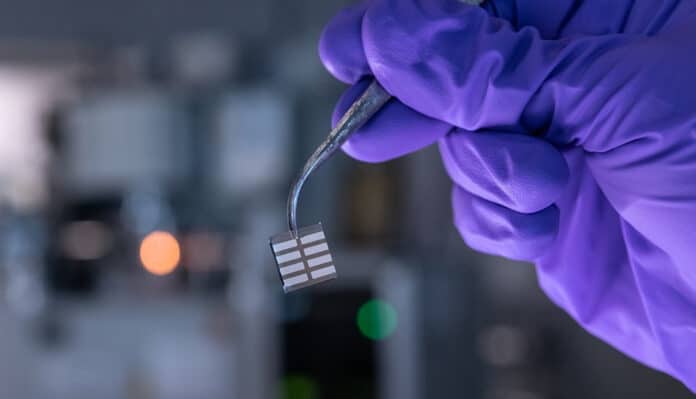Solar cells are a vital part of the green energy transition. They can be used not only on rooftops and solar farms but also for powering autonomous vehicles, such as planes and satellites. However, photovoltaic solar cells are currently heavy and bulky, making them difficult to transport to remote locations off-grid, where they are much needed.
Now, a team of researchers from Imperial College London, Cambridge, UCL, Oxford, Helmholtz-Zentrum Berlin in Germany, and others has produced materials that can absorb comparable levels of sunlight more strongly than conventional solar cell technologies and can be printed from ink. The material can harvest sunlight using layers only 1/500th the thickness of a strand of hair.
The new green material researchers found is sodium bismuth sulfide (NaBiS2), which is grown as nanocrystals and deposited from solution to make films 30 nanometers in thickness. NaBiS2 is comprised of nontoxic elements that are sufficiently abundant in the earth’s crust for use commercially.
“We have found a material that absorbs light more strongly than conventional solar cell technologies and can be printed from an ink,” says Yi-Teng Huang, a Ph.D. student at the University of Cambridge and co-first author. “This technology has potential for making lightweight solar cells which can be easily transported or used in aerospace applications.”
The sodium and bismuth ions in NaBiS2 have similar sizes, which means that instead of occupying different crystallographic sites (ordered), they occupy the same site (disordered). As a result, the crystal structure changes to rocksalt, which resembles table salt. But sodium and bismuth are not uniformly distributed in the material, and this has a significant effect on absorption strength.
“Disorder has long been seen as the enemy of solar cells. Known to kill efficiency in conventional solar materials like silicon (Si), cadmium telluride (CdTe), and gallium arsenide (GaAs), researchers have typically focused on avoiding it at all costs. This work, along with other recent studies from our and other groups, shows that this is not necessarily the case,” said Seán Kavanagh, co-first author of the research. “Rather, if we can understand and control this disorder, it can present a powerful tool to tune material properties and yield record-breaking performance in a wide range of applications, not just solar cells but also LEDs and thermoelectrics, for instance. It’s an exciting prospect for materials research!”
The researchers also found that the disorder has a significant and unusual effect on the transport of photogenerated charges in the material. An inhomogeneous distribution of sodium and bismuth ions results in localized electronic states forming, which rapidly capture charges. These charges live in these states for tens of microseconds, which is at least 100 times longer than in other novel semiconductors.
Also, they found that atomic defects play a negligible role in NaBiS2 because the transport of charges is dominated by the effects of these localized states. These results demonstrate the importance of controlling the degree of disorder and understanding the influence on the electronic states in materials.
The research also showed that NaBiS2 is stable in air for the entire duration of their 11-month test without any encapsulation required. This suggests the long-term durability of the material in devices, which is a key requirement for commercial solar cells.
Researchers envision that these findings will spark greater interest in NaBiS2 and similar materials, especially in understanding the role of cation disorder and the interactions between charges and the crystal lattice.
